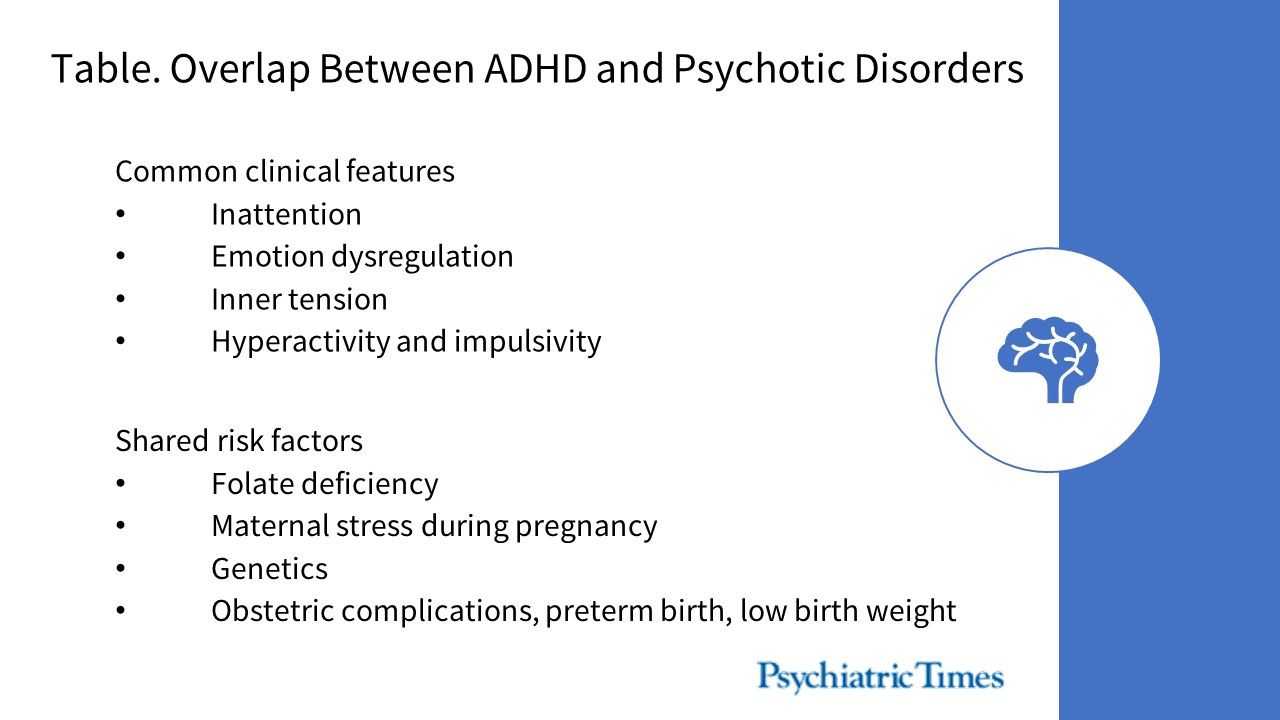Article
Examining the Relationship Between ADHD and Psychotic Disorders
Author(s):
There is evidence for overlapping risk factors and symptomatology between ADHD and psychotic disorders. New research investigates the association between ADHD during childhood and the subsequent risk of developing a psychotic disorder.
MarinaZlochin/AdobeStock

RESEARCH UPDATE
Attention-deficit/hyperactivity disorder (ADHD) is frequently associated with other psychiatric conditions, including psychotic disorders. There is evidence for shared genetic susceptibility to both conditions,1 and first-degree relatives of people with ADHD have twice the risk of having schizophrenia compared with healthy controls.2
There is also an added risk of psychosis in patients with comorbid cannabis use. There are overlapping environmental risk factors for both disorders, including obstetric complications, preterm birth, and low birth weight.3 There are also abnormalities in overlapping dopaminergic brain circuits in schizophrenia and ADHD.4 However, epidemiologic evidence for the association between psychotic disorders and ADHD remains inconsistent.
Nourredine and colleagues5 performed a systematic review and meta-analysis of the association between ADHD during childhood and the subsequent risk of developing a psychotic disorder. The authors searched MEDLINE, Scopus, PsycInfo, and Web of Science from inception through November 2015. They included peer-reviewed case-control and cohort studies of children younger than 18 with ADHD (using any recognized diagnostic criteria) with a comparison group.
The primary outcome was occurrence of any psychotic disorder (also using any recognized diagnostic criteria; including schizophrenia, schizophreniform disorder, brief psychotic disorder, schizoaffective disorder, delusional disorder, psychotic disorder not otherwise specified, or schizotypal personality disorder) at or after aged 18 years following a diagnosis of ADHD. They excluded studies with attention deficits or impulsivity without any ADHD diagnosis or adult ADHD diagnosis, or psychotic disorders that were diagnosed before or concurrently with ADHD.
Relevant data—including relative risks (RR), odds ratios (OR), hazard ratios (HR), and 95% confidence intervals—were extracted for each study. An assessment of risk of bias and study quality was performed for each included study. Pooled measures of relative effects (eg, RR, OR, HR) were calculated using random-effects meta-analysis. Egger’s test and funnel plots were used to assess for potential publication bias. Subgroup and meta-regression analyses were performed for study design, sex, treatment, relevant psychiatric comorbidities, and type of outcome, but data were not available regarding substance use comorbidity.
The authors screened 3782 records and assessed 45 full-text articles for eligibility. After review, 15 studies (1 case-control and 14 cohorts) were included in the systematic review and 12 studies (1.85 million unique participants) were included in the meta-analysis. The median prevalence of psychotic disorder in the cohort studies was 0.5% for controls and 2.7% for the ADHD population, corresponding to an approximately 5-fold increased risk of subsequent psychotic disorder in children with ADHD (relative effect = 4.74, 95% CI 4.11-5.46).
Findings were similar in subgroup analyses (including schizophrenia versus other psychotic disorders, as well as the presence or absence of follow-up after aged 18 years). In meta-regression analyses, sex, and study quality did not moderate the association. There was no evidence of publication bias.
The authors performed the first meta-analysis of observational studies on the association between ADHD and psychotic disorders. They note that substance use disorder comorbidity is common to both conditions, and that the effects of psychostimulants are also an important consideration, as there is inconsistent evidence on the possible association between chronic psychostimulant treatment and subsequent risk of psychotic disorder.
There was inadequate data to consider effects of either substance use or psychostimulants in the present meta-analysis, and thus this information is relevant to future studies. They also note that psychotic symptoms and ADHD symptoms may overlap and can be confused and misdiagnosed (Table). Strengths of the study included the large sample size and absence of publication bias. Limitations include clinical heterogeneity in the study populations, diagnostic criteria, and outcomes.
CASE VIGNETTE
“Mr D” is a 21-year-old African American male outpatient at the community mental health center. He has a diagnosis of ADHD, combined type, and as a child, he received remote treatment with an unknown stimulant medication. His sister has depression, but his family history is otherwise unremarkable. At age 19, he was admitted for 1 week to the state psychiatric hospital because he had command auditory hallucinations for self-harm and began banging his head against the wall. He subsequently received a diagnosis of schizophrenia and cannabis use disorder. For the past year, he has been clinically stable on antipsychotic medication without additional psychiatric hospitalizations.
The Bottom Line
A childhood diagnosis of ADHD increased the risk of subsequent psychotic disorder almost 5-fold, independent of sex and diagnostic outcome (schizophrenia versus other psychotic disorder). Early detection (and management) of psychotic disorders in children with an ADHD diagnosis is essential.
References
1. Hamshere ML, Stergiakouli E, Langley K, et al. Shared polygenic contribution between childhood attention-deficit hyperactivity disorder and adult schizophrenia. Br J Psychiatry. 2013;203(2):107-111.
2. Larsson H, Rydén E, Boman M, et al. Risk of bipolar disorder and schizophrenia in relatives of people with attention-deficit hyperactivity disorder. Br J Psychiatry. 2013;203(2):103-106
3. Linnet KM, Dalsgaard S, Obel C, et al. Maternal lifestyle factors in pregnancy risk of attention deficit hyperactivity disorder and associated behaviors: review of the current evidence. Am J Psychiatry. 2003;160(6):1028-1040
4. Howes OD, Kambeitz J, Kim E, et al. The nature of dopamine dysfunction in schizophrenia and what this means for treatment. Arch Gen Psychiatry. 2012;69(8):776-786.
5. Nourredine M, Gering A, Fourneret P, et al. Association of attention-deficit/hyperactivity disorder in childhood and adolescence with the risk of subsequent psychotic disorder: a systematic review and meta-analysis. JAMA Psychiatry. 2021 Feb 24;e204799.







